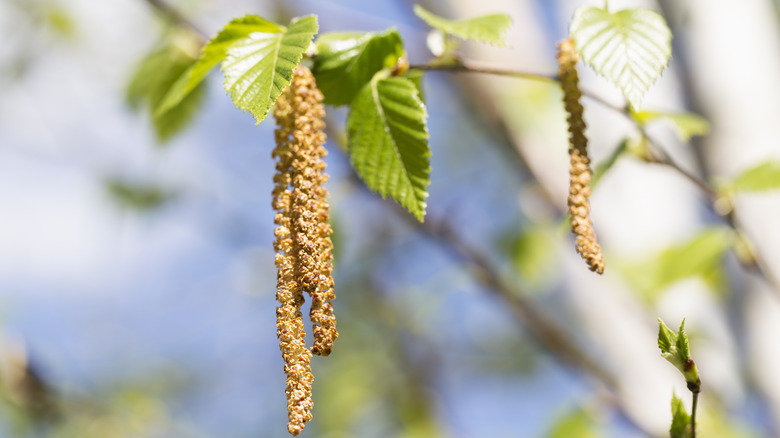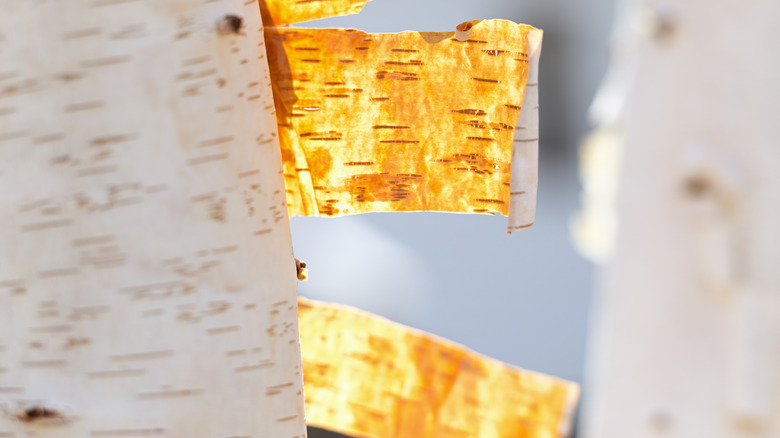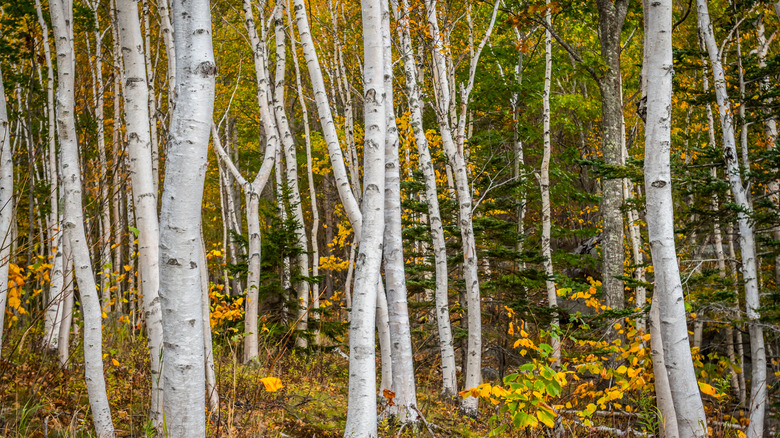The Type Of Birch Tree You'll Want To Avoid Planting Near Your Pool Or Patio
Birch trees are beautiful, slender, and graceful specimens in the tree world. Native to much of the U.S. and Canada, various species of birch can be found from the Northwest, Canadian wilderness, and Alaska all the way down to Florida. With such a wide range for this common tree, you may be under the impression that a "birch is a birch," but think again. There is a great deal of difference between types of birch trees, and some of the distinctions might prove nuisances if you select the wrong kind or can't find the best place in your yard to grow it.
Paper birch is an iconic birch tree found in northern climates (USDA hardiness zones 2 through 7). Historically, it has been used for everything from canoes (which were carved out of its trunks), to birch syrup (tapped directly from the trees). If you reside in a region of the country that is home to the paper birch, you may be inclined to plant one on your property, perhaps near a walkway or close to your swimming pool — wouldn't that be a graceful addition to your yard?
Not so fast. Paper birch is notoriously messy, shedding its thin bark, flowers, seeds, leaves, and branches throughout the year. This messiness will present you with the part-time occupation of cleaning debris from your property, and we haven't even yet mentioned the vast number of enemies the paper birch has in the insect world.
The problematic paper birch
The paper birch sheds a vast amount of catkins, seeds, leaves, bark, and branches. This makes them an unideal option for your yard or garden, especially if you have a pool or patio you regularly enjoy. With a large enough property, you could plant a paper birch in a faraway corner from your outdoor living space, but beware that birch seeds, bark, and leaves can be carried by the wind and litter your property, no matter how careful you were to provide some separation. Consider planting them in a garden with plenty of leafy green shrubs and bushes, so any fallen bark can decompose and enrich the soil or mulch covering for other plants.
As it's more amenable to cold weather, this tree is unlikely to thrive in zones much hotter than zone 6 and could become more vulnerable if installed in a hot locale. Although there is conflicting information online, the wood of the paper birch can also potentially be toxic to humans.
The paper birch tree is also preyed upon by insects. The bronze birch borer is known to attack older trees or those that are not as resilient. Forest tent caterpillars are another major player in the demise of paper birch trees, as they defoliate (or remove leaves from) the birch, weakening its overall state and leading to easier destruction by borers and other insects. While these insects are not usually the primary adversaries of paper birches, if they get access to your trees, they'll gradually weaken their integrity, making recovery all but impossible.
Better alternatives to paper birch
While the paper birch isn't the right tree for everyone's yard, don't despair if you had your heart set on a birch tree, as there are other options available. The river birch is a far more versatile variety than its papery counterpart, as it's resistant to many boring bugs and is documented as having no serious threats from insects. The river birch can also be successfully grown in far warmer climates (zones 4 to 9). River birch is, in fact, commonly planted in Florida, where it happily thrives, and is the only species of birch found in the Southern U.S. Unfortunately, if you are looking for a tree that is not messy, chances are you won't find it in the river birch, as this species is also notorious for losing leaves, bark, and branches throughout the year. The river birch will, however, provide fast growth and shade.
Open to a less messy option and willing to branch out from the birch family? You will find a number of similarities (at least visually) in the aspen tree, but they are not without their fair share of challenges, either. While they are also known for shedding a plentiful amount of leaves, they do not lose their white bark as the paper birch does. You can grow an aspen in USDA hardiness zones 2 to 8, but they should not be planted near buildings due to their aggressive root systems. If you'd love to be the proud grower of an aspen tree, check out our guide on how to grow and care for aspen trees.


